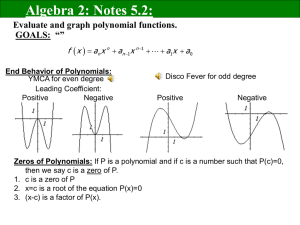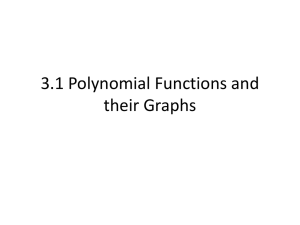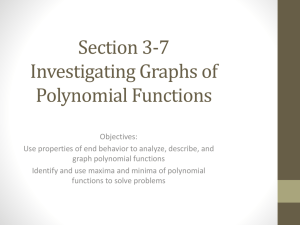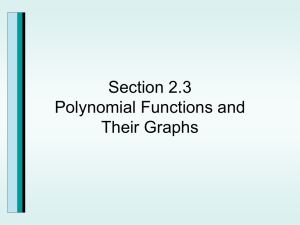Polynomial Function
advertisement
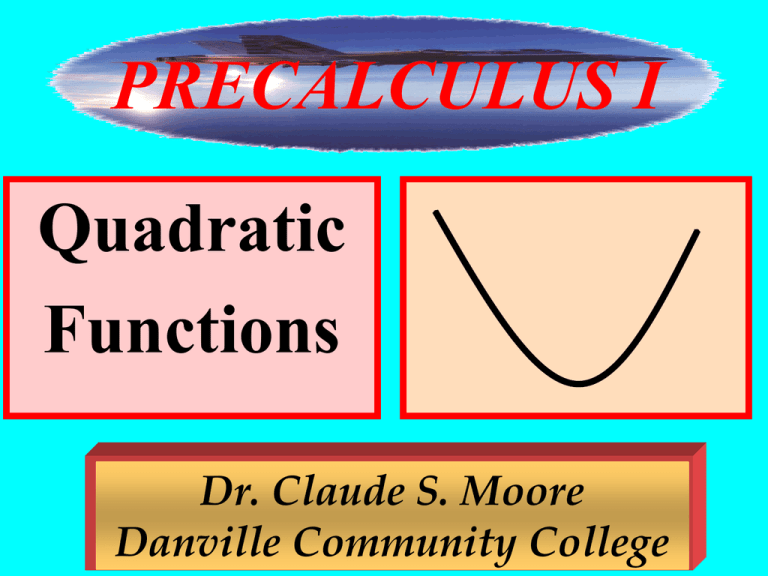
PRECALCULUS I
Quadratic
Functions
Dr. Claude S. Moore
Danville Community College
1
Polynomial Function
A polynomial function of degree n is
n
f ( x) an x an 1 x
n 1
a0
where the a’s are real numbers and
the n’s are nonnegative integers
and an 0.
Quadratic Function
A polynomial function of degree 2
is called a quadratic function.
It is of the form
2
f ( x) ax bx c
a, b, and c are real numbers
and a 0.
Axis of Symmetry
For a quadratic function of the
form
2
f ( x) ax bx c
b
x
2a
gives the axis of
symmetry.
Standard Form
A quadratic function of the form
2
f ( x) a( x h) k , a 0
is in standard form.
axis of symmetry: x = h
vertex: (h, k)
Characteristics of Parabola
a>0
axis of symmetry
vertex: maximum
vertex: minimum
axis of symmetry
a<0
PRECALCULUS I
Higher Degree
Polynomial Functions
Dr. Claude S. Moore
Danville Community College
7
Characteristics
The graph of a polynomial function…
1. Is continuous.
2. Has smooth, rounded turns.
3. For n even, both sides go same way.
4. For n odd, sides go opposite way.
5. For a > 0, right side goes up.
6. For a < 0, right side goes down.
Leading Coefficient Test: n odd
n
f ( x) an x an 1 x
n 1
a0
graphs of a polynomial function for n odd:
.
an > 0
an < 0
f ( x)
f ( x)
as x
as x
f ( x)
f ( x)
as x
as x
Leading Coefficient Test: n even
n
f ( x) an x an 1 x
n 1
a0
graphs of a polynomial function for n even:
.
an < 0
an > 0
f ( x)
f ( x)
as x
as x
f ( x)
f ( x)
as x
as x
Roots, Zeros, Solutions
The following statements are equivalent for
real number a and polynomial function f :
1. x = a is root or zero of f.
2. x = a is solution of f (x) = 0.
3. (x - a) is factor of f (x).
4. (a, 0) is x-intercept of graph of f (x).
Repeated Roots (Zeros)
1. If a polynomial function contains
k
a factor (x - a) , then x = a is a
repeated root of multiplicity k.
2. If k is even, the graph touches
(not crosses) the x-axis at x = a.
3. If k is odd, the graph crosses the
x-axis at x = a.
Intermediate Value Theorem
If a < b are two real numbers
and f (x)is a polynomial function
with f (a) f (b),
then f (x) takes on every real
number value between
f (a) and f (b) for a x b.
NOTE to Intermediate Value
Let f (x) be a polynomial function
and a < b be two real numbers.
If f (a) and f (b)
have opposite signs
(one positive and one negative),
then f (x) = 0 for a < x < b.
PRECALCULUS I
Polynomial and
Synthetic Division
Dr. Claude S. Moore
Danville Community College
15
Full Division Algorithm
If f (x) and d(x) are polynomials
with d(x) 0 and the degree of d(x) is
less than or equal to the degree of f(x),
then q(x) and r (x) are unique
polynomials such that
f (x) = d(x) ·q(x) + r (x)
where r (x) = 0 or
has a degree less than d(x).
Short Division Algorithm
f (x) = d(x) ·q(x) + r (x)
dividend
quotient
divisor
remainder
where r (x) = 0 or
has a degree less than d(x).
Synthetic Division
3
ax +
2
bx
k
a
+ cx + d divided by x - k
b
c
d
ka
a
coefficients of quotient
r
remainder
1. Copy leading coefficient.
2. Multiply diagonally. 3. Add vertically.
Remainder Theorem
If a polynomial f (x)
is divided by x - k,
the remainder is r = f (k).
Factor Theorem
A polynomial f (x)
has a factor (x - k)
if and only if f (k) = 0.
PRECALCULUS I
Real Zeros of
Polynomial Functions
Dr. Claude S. Moore
Danville Community College
21
Descartes’s Rule of Signs
n
f ( x) an x an 1 x
n 1
a0
a’s are real numbers, an 0, and a0 0.
1. Number of positive real zeros of f equals
number of variations in sign of f(x), or
less than that number by an even integer.
2. Number of negative real zeros of f equals
number of variations in sign of f(-x), or
less than that number by an even integer.
Example 1: Descartes’s Rule of Signs
3
2
f ( x) 4 x 5 x 6
a’s are real numbers, an 0, and a0 0.
1. f(x) has two change-of-signs; thus, f(x)
has two or zero positive real roots.
2. f(-x) = -4x3 5x2 + 6 has one change-ofsigns; thus, f(x) has one negative real
root.
Example 2: Descartes’s Rule of Signs
3
2
f ( x) 4 x 5 x 6 x
Factor out x; f(x) = x(4x2 5x + 6) = xg(x)
1. g(x) has two change-of-signs; thus, g(x)
has two or zero positive real roots.
2. g(-x) = 4x2 + 5x + 6 has zero change-ofsigns; thus, g(x) has no negative real root.
Rational Zero Test
n
f ( x) an x an 1 x
n 1
a0
If a’s are integers, every rational
zero of f has the form
rational zero = p/q,
in reduced form, and p and q are
factors of a0 and an, respectively.
Example 3: Rational Zero Test
3
2
f(x) = 4x 5x + 6
p {1, 2, 3, 6}
q {1, 2, 4}
p/q {1, 2, 3, 6,
1/2, 1/4, 3/2, 3/4}
represents all possible rational roots
of f(x) = 4x3 5x2 + 6 .
Upper and Lower Bound
f(x) is a polynomial with real coefficients
and an > 0 with
f(x) (x - c), using synthetic division:
1. If c > 0 and each # in last row is either
positive or zero, c is an upper bound.
2. If c < 0 and the #’s in the last row
alternate positive and negative, c is an
lower bound.
Example 4: Upper and Lower Bound
3
2x
-3
12x + 8 divided by x + 3
2
-3
-12
8
2
3x
-6
27
-45
2
-9
15
-37
c = -3 < 0 and #’s in last row alternate
positive/negative. Thus, x = -3 is a
lower bound to real roots.



